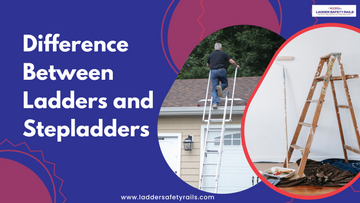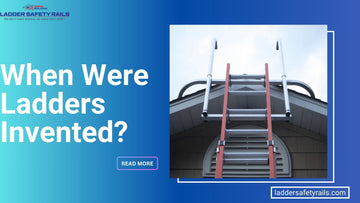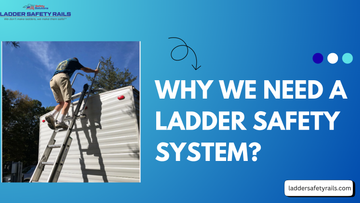
When it comes to reaching high places for tasks around the house or at a job site, having the right equipment is essential. Two commonly used tools for such purposes are ladders and stepladders. Despite their similarities, there are distinct differences between them that can affect their suitability for various tasks. In this blog, we will delve into the characteristics, uses, and differences between ladders and stepladders, ensuring you have all the information you need to choose the right tool for your needs.
What is a Ladder?
A ladder is a piece of equipment that consists of two long side supports with rungs or steps between them. Ladders can be made from various materials, including wood, aluminum, and fiberglass. They are typically designed to lean against a wall or other surface for support. Ladders come in different types, such as extension ladders, which can be adjusted to different lengths, and fixed ladders, which are set at a specific height.
Key Features of Ladders:
- Length: Ladders can be very long, allowing users to reach significant heights.
- Material: Common materials include wood, aluminum, and fiberglass, each offering different benefits.
- Portability: Ladders are generally portable, though longer ladders can be cumbersome.
- Stability: Must be placed against a stable surface to be used safely.

What is a Stepladder?
A stepladder, on the other hand, is a self-supporting ladder that consists of two sets of legs joined at the top by a hinge. Stepladders can be folded for easy storage and typically have flat steps and a platform at the top. They are designed to be freestanding, making them ideal for tasks that require mobility and stability without needing to lean against a wall.
Key Features of Stepladders:
- Self-Supporting: Can stand independently without the need for additional support.
- Foldable: Easy to store and transport due to their foldable design.
- Steps: Flat steps provide a stable surface for standing.
- Platform: Often includes a platform at the top for added convenience and safety.
Types of Ladders
Before diving into the differences between ladders and stepladders, it’s important to understand the various types of ladders available. Here are some common types:
1. Extension Ladders:
- Description: These ladders consist of two or more sections that can be extended to reach various heights.
- Use: Ideal for tasks that require reaching high places, such as painting tall buildings or cleaning gutters.
- Pros: Versatile in height, can be compacted for storage.
- Cons: Require a stable surface to lean against.
2. Telescopic Ladders:
- Description: These ladders can be extended and locked at different heights. The ladder is retractable for compact size for storage.
- Use: Suitable for both indoor and outdoor tasks where varying heights are needed.
- Pros: Highly portable, space-saving design.
- Cons: Typically more expensive, require careful operation to ensure safety.
3. Fixed Ladders:
- Description: These are permanently attached ladders, often found in industrial settings, such as on the sides of tanks or silos.
- Use: Ideal for locations where regular access is required.
- Pros: Always available at the location, very sturdy.
- Cons: Not portable, limited to specific locations.
Ladder vs. Stepladder: Key Differences
When comparing a ladder vs. a stepladder, several key differences stand out:
Support and Stability:
- Ladders: Require a stable surface to lean against for support. They can be less stable if the surface is uneven or slippery.
- Stepladders: Are self-supporting and can be placed anywhere on a flat surface. They offer greater stability for various tasks.
Height and Reach:
- Ladders: Can extend to significant heights, making them suitable for outdoor tasks like cleaning gutters, accessing roofs or painting tall structures.
- Stepladders: Generally shorter, making them more suitable for indoor tasks like changing light bulbs or reaching high shelves.
Portability and Storage:
- Ladders: Longer ladders can be cumbersome to move and store. However, extension ladders and telescopic ladders can be compacted for easier storage.
- Stepladders: Foldable design makes them easy to store and transport, even in small spaces.
Usage:
- Ladders: Best for tasks that require reaching great heights or when a leaning surface is available.
- Stepladders: Ideal for tasks that require frequent moving and do not have a leaning surface, such as interior decorating or minor household repairs.

Telescopic Ladder vs. Stepladder
Some telescopic ladders also have the ability to maintain A- frames. In such a case, stepladders and telescopic ladders both offer unique advantages, and they are suited to different types of tasks.
-
Telescopic Ladders:
These ladders are highly versatile due to their adjustable height. They can be extended to reach high places or retracted for compact storage, making them ideal for tasks that require varying heights. Telescopic ladders are also portable and can be easily transported in a car, making them convenient for professionals who move between job sites. However, they require careful handling to ensure each section is securely locked before use.
-
Stepladders:
Stepladders, being self-supporting, are more stable on flat surfaces and can be used without needing a wall or other support to lean against. This makes them particularly useful for indoor tasks and activities that require frequent repositioning. They are also easier to set up and take down compared to telescopic ladders. The foldable design of stepladders means they can be stored compactly, but they generally do not offer the same height range as telescopic ladders.
Choosing the Right Tool
When choosing between a ladder and a stepladder, consider the task at hand and the environment in which you will be working. Here are some tips to help you make the right choice:
1. Task Requirements:
- For tasks that require reaching significant heights, such as roof repairs or outdoor painting, a ladder is the better choice.
- For indoor tasks or tasks that require mobility and stability, such as hanging pictures or cleaning, a stepladder is more suitable.
2. Storage Space:
- If storage space is limited, a foldable stepladder is easier to store than a long ladder.
- Consider a telescopic ladder if you need the height but have limited storage space.
3. Safety:
- Always ensure that the ladder or stepladder is placed on a flat, stable surface.
- Never exceed the maximum weight capacity of the ladder or stepladder.
- Use the appropriate ladder or stepladder for the task to avoid accidents.
Conclusion
Understanding the differences between ladders and stepladders is essential for choosing the right tool for your needs. Ladders offer the ability to reach great heights but require a stable surface for support, while stepladders provide mobility and stability with their self-supporting design. Telescopic ladders, with their adjustable height and compact storage, offer another versatile option. By considering the specific requirements of your task and following safety guidelines, you can effectively and safely use ladders and stepladders for a wide range of activities.
Remember, whether you are using a ladder, telescopic ladder, or stepladder, safety should always come first. Proper inspection, setup, and usage will ensure that you can complete your tasks efficiently and without accidents.
FAQs
-
Are ladders and stepladders the same thing?
No, ladders and stepladders are not the same. Ladders need a stable surface to lean against, while stepladders are self-supporting and can stand independently.
-
What are the steps on a ladder called?
The steps on a ladder are called rungs. These rungs provide the footing for climbing up or down the ladder.
-
Can we use a stepladder as a straight ladder?
No, a stepladder cannot be used as a straight ladder. Stepladders are designed to be self-supporting and cannot be safely used in a leaning position like a straight ladder.
Read more Blogs Here:






